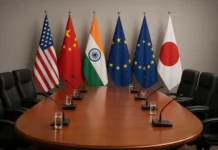The 21st century has marked a dramatic rebalancing of global power. For centuries, economic and political dominance rested in the hands of Western nations — led by Europe and the United States. But today, Asia stands at the center of global transformation.
From booming economies in China and India to technological revolutions in South Korea, Japan, and Singapore, Asia is no longer a “developing” region — it is the engine of global growth. The shift from West to East is not just economic; it’s geopolitical, cultural, and digital.
Economic Ascendancy: Asia’s Unstoppable Growth
Asia’s economic rise has been the most significant story of globalization. Together, China, India, Japan, and Southeast Asia now account for nearly 45% of global GDP (PPP terms) — compared to just 10% in 1980.
China’s growth story remains unmatched. Since its market reforms in 1978, it has lifted more than 800 million people out of poverty and become the world’s second-largest economy. India, meanwhile, has emerged as a service and technology powerhouse, with a young, digitally empowered population and rapidly expanding middle class.
Even smaller nations — Vietnam, Indonesia, and Bangladesh — are now recognized as the next manufacturing and investment hubs, attracting global companies seeking alternatives to China.
This growth has transformed Asia from a regional player into a central pillar of global demand, trade, and capital movement.
The Shift in Global Trade and Supply Chains
The COVID-19 pandemic and subsequent disruptions exposed the world’s dependence on Asian supply chains. From semiconductors to pharmaceuticals and consumer electronics, Asia is the manufacturing backbone of the global economy.
However, this dominance also gives Asia geopolitical leverage. Countries like China and India are using their industrial scale to negotiate new trade routes and partnerships — such as the Regional Comprehensive Economic Partnership (RCEP), the world’s largest trade pact, signed in 2020.
As the U.S. and Europe reconsider their economic dependencies, “friend-shoring” and supply chain diversification efforts are already underway. Yet, Asia remains irreplaceable in the near future, both as a producer and as a market of 4.5 billion consumers.
The Geopolitical Power Shift
Economic dominance naturally translates into political and strategic influence.
The 21st century has witnessed Asia’s emergence as a decisive player in global diplomacy.
-
China’s Belt and Road Initiative (BRI) has expanded Beijing’s influence across Asia, Africa, and Europe.
-
India’s Act East and Indo-Pacific strategies have positioned it as a balancing force between the West and China.
-
ASEAN nations are now critical in shaping trade and maritime security in the South China Sea.
The United States’ “Pivot to Asia” policy acknowledges this power shift. Yet, competition — especially between China and the U.S. — defines the new geopolitical reality. The 21st century is increasingly multipolar, and Asia sits at its core.
The Rise of Asian Innovation and Technology
Asia’s rise isn’t limited to industry and trade — it’s also a hub of innovation.
Countries like South Korea, Japan, Singapore, and China are leading the world in AI research, robotics, quantum computing, and 5G technology.
China’s tech giants — Alibaba, Tencent, and Huawei — rival Silicon Valley, while India’s startup ecosystem has produced over 100 unicorns, making it one of the fastest-growing innovation landscapes globally.
Asia’s combination of digital infrastructure, skilled labor, and massive user base gives it a unique competitive edge in shaping the future of technology — from fintech and gaming to artificial intelligence and renewable energy.
Cultural and Soft Power Influence
Beyond economics and technology, Asia’s cultural rise is reshaping global narratives. The success of K-pop, anime, Bollywood, and Asian cuisine highlights the region’s expanding soft power.
Streaming platforms like Netflix and YouTube have globalized Asian content, making it a cornerstone of international entertainment. Countries are now exporting culture alongside commerce, reinforcing Asia’s image as a creative and modern region rather than a manufacturing base alone.
Cultural diplomacy — led by media, art, and education — has become a strategic tool for influence, complementing Asia’s hard power.
Challenges in the Asian Century
Despite its success, Asia’s rise faces critical challenges.
-
Income inequality remains high across several countries.
-
Environmental degradation and climate change pose existential risks to agriculture and urban life.
-
Regional tensions — from the South China Sea disputes to India–China border issues — threaten long-term stability.
Furthermore, demographic shifts are emerging: Japan, South Korea, and China face aging populations, while nations like India and Indonesia are struggling to provide enough jobs for their youth.
For Asia to maintain its momentum, governance reforms, sustainability, and inclusive growth will be crucial in the decades ahead.
The Future of Global Leadership
As Asia continues to expand its influence, the question arises — will it replace the West as the center of global power?
The reality is more complex. Rather than a simple handover, the 21st century is likely to witness a power-sharing arrangement where Asia leads in economic and technological spheres while Western nations retain dominance in finance, defense, and institutional governance.
However, the “Asian Century” is already shaping global policymaking, multilateral institutions, and even climate agendas. The balance of power is now distributed — not centralized — and Asia’s rise has made the global order more dynamic and interdependent than ever.
Conclusion
The rise of Asia is not a passing phase — it is the defining phenomenon of our era. Economic ambition, technological innovation, and cultural influence have converged to turn Asia into the new center of global gravity.
Yet, with great power comes great responsibility. How Asian nations manage their growth, navigate rivalries, and promote sustainable progress will determine not only the future of the continent but the destiny of the world itself.
The 21st century belongs to Asia, but the world will watch closely to see how wisely that power is used.




